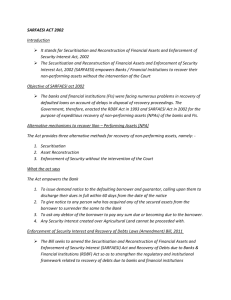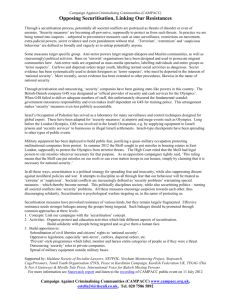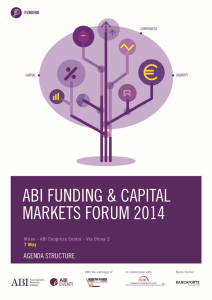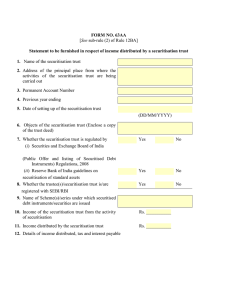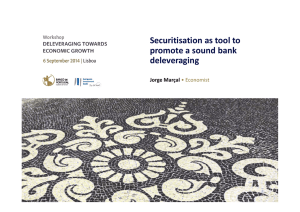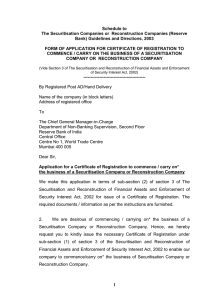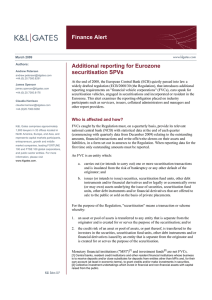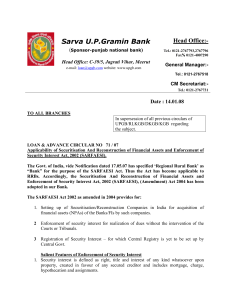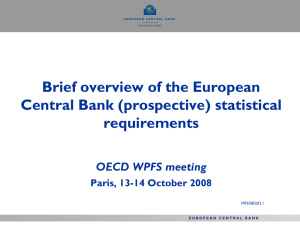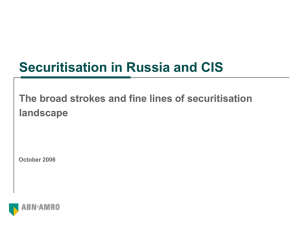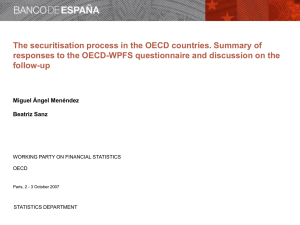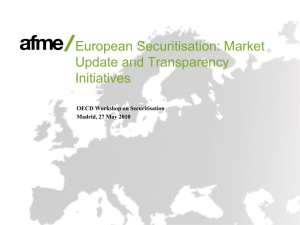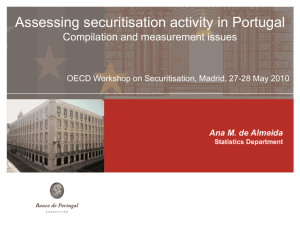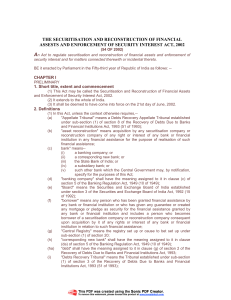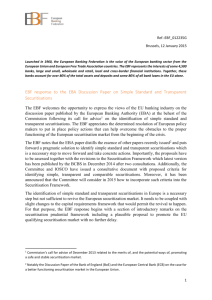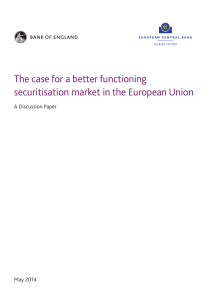View the Note on SARFESI
advertisement
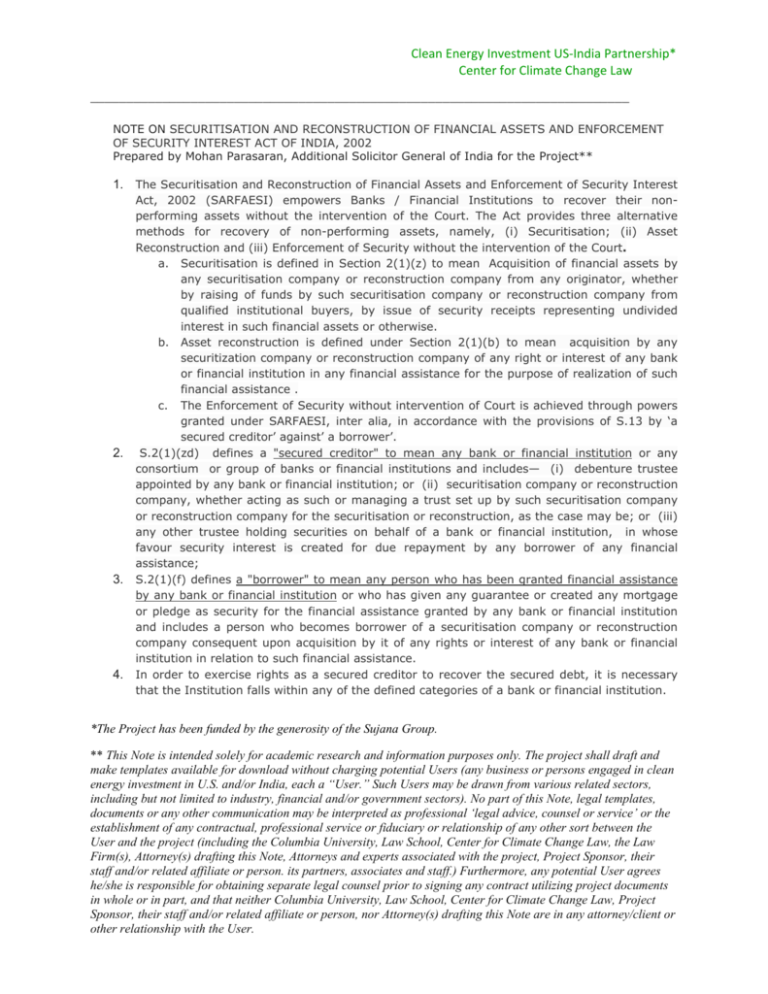
Clean Energy Investment US‐India Partnership* Center for Climate Change Law ___________________________________________________________________________ NOTE ON SECURITISATION AND RECONSTRUCTION OF FINANCIAL ASSETS AND ENFORCEMENT OF SECURITY INTEREST ACT OF INDIA, 2002 Prepared by Mohan Parasaran, Additional Solicitor General of India for the Project** 1. The Securitisation and Reconstruction of Financial Assets and Enforcement of Security Interest 2. 3. 4. Act, 2002 (SARFAESI) empowers Banks / Financial Institutions to recover their nonperforming assets without the intervention of the Court. The Act provides three alternative methods for recovery of non-performing assets, namely, (i) Securitisation; (ii) Asset Reconstruction and (iii) Enforcement of Security without the intervention of the Court. a. Securitisation is defined in Section 2(1)(z) to mean Acquisition of financial assets by any securitisation company or reconstruction company from any originator, whether by raising of funds by such securitisation company or reconstruction company from qualified institutional buyers, by issue of security receipts representing undivided interest in such financial assets or otherwise. b. Asset reconstruction is defined under Section 2(1)(b) to mean acquisition by any securitization company or reconstruction company of any right or interest of any bank or financial institution in any financial assistance for the purpose of realization of such financial assistance . c. The Enforcement of Security without intervention of Court is achieved through powers granted under SARFAESI, inter alia, in accordance with the provisions of S.13 by ‘a secured creditor’ against’ a borrower’. S.2(1)(zd) defines a "secured creditor" to mean any bank or financial institution or any consortium or group of banks or financial institutions and includes— (i) debenture trustee appointed by any bank or financial institution; or (ii) securitisation company or reconstruction company, whether acting as such or managing a trust set up by such securitisation company or reconstruction company for the securitisation or reconstruction, as the case may be; or (iii) any other trustee holding securities on behalf of a bank or financial institution, in whose favour security interest is created for due repayment by any borrower of any financial assistance; S.2(1)(f) defines a "borrower" to mean any person who has been granted financial assistance by any bank or financial institution or who has given any guarantee or created any mortgage or pledge as security for the financial assistance granted by any bank or financial institution and includes a person who becomes borrower of a securitisation company or reconstruction company consequent upon acquisition by it of any rights or interest of any bank or financial institution in relation to such financial assistance. In order to exercise rights as a secured creditor to recover the secured debt, it is necessary that the Institution falls within any of the defined categories of a bank or financial institution. *The Project has been funded by the generosity of the Sujana Group. ** This Note is intended solely for academic research and information purposes only. The project shall draft and make templates available for download without charging potential Users (any business or persons engaged in clean energy investment in U.S. and/or India, each a “User.” Such Users may be drawn from various related sectors, including but not limited to industry, financial and/or government sectors). No part of this Note, legal templates, documents or any other communication may be interpreted as professional ‘legal advice, counsel or service’ or the establishment of any contractual, professional service or fiduciary or relationship of any other sort between the User and the project (including the Columbia University, Law School, Center for Climate Change Law, the Law Firm(s), Attorney(s) drafting this Note, Attorneys and experts associated with the project, Project Sponsor, their staff and/or related affiliate or person. its partners, associates and staff.) Furthermore, any potential User agrees he/she is responsible for obtaining separate legal counsel prior to signing any contract utilizing project documents in whole or in part, and that neither Columbia University, Law School, Center for Climate Change Law, Project Sponsor, their staff and/or related affiliate or person, nor Attorney(s) drafting this Note are in any attorney/client or other relationship with the User. Clean Energy Investment US‐India Partnership* Center for Climate Change Law 5. The term ‘Bank’ is also defined under the SARFAESI to mean (i) a banking company; or (ii) a corresponding new bank; or (iii) the State Bank of India; or (iv) a subsidiary bank; or (v) such other bank which the Central Government may, by notification, specify for the purposes of this Act. A "banking company" shall have the meaning assigned to it in clause (c) of section 5 of the Banking Regulation Act, 1949 (10 of 1949). 6. The term "financial institution" is defined to mean (i) a public financial institution within the meaning of section 4A of the Companies Act, 1956 (1 of 1956); any institution specified by the Central Government under sub-clause (ii) of clause (h) of section 2 of the Recovery of Debts Due to Banks and Financial Institutions Act, 1993 (51 of 1993); (iii) the International Finance Corporation established under the International Finance Corporation (Status, 7. Immunities and Privileges) Act, 1958 (42 of 1958) and (iv) any other institution or nonbanking financial company as defined in clause (f) of section 45-I of the Reserve Bank of India Act, 1934 (2 of 1934), which the Central Government may, by notification, specify as financial institution for the purposes of this Act. 8. In this regard it may be noted that the category of Banks is well defined and powers are vested with the Central Government to notify a particular institution as a ‘bank’ for the purposes of the Act. 9. For the large part institutions that are not ‘banks’ in India will typically come within the fold of a secured creditor under SARFAESI by either being a Public Financial Institution within the meaning of S.4A of the Companies Act,1956 or will be an institution or NBFC under the RBI Act and will be notified by the Central Government. 10. The Ministry of Corporate Affairs has laid down guidelines for declaring a financial institution as Public Financial Institution under Section 4A of the Companies Act, 1956 vide General circular no. 34/2011 dated 2-06-2011. Every financial institution applying for declaration as a PFI shall fulfill the following criteria; (i) It should be established under a Special Act or Companies Act being Central Act , (ii) The net worth of the Company should be rupees one thousand crore , (iii) Their main business should be infrastructural or industrial financing , (iv) It must be in existence for at least 3 years also their income from industrial/infrastructure financing should be exceeding 50% of their income, (v) The company is registered as Infrastructure Finance Company with Reserve Bank of India(RBI) or as an Housing Finance Company with National Housing Bank(NHB). See http://www.mca.gov.in/Ministry/pdf/Circular_34‐2011_02jun2011.pdf *The Project has been funded by the generosity of the Sujana Group. ** This Note is intended solely for academic research and information purposes only. The project shall draft and make templates available for download without charging potential Users (any business or persons engaged in clean energy investment in U.S. and/or India, each a “User.” Such Users may be drawn from various related sectors, including but not limited to industry, financial and/or government sectors). No part of this Note, legal templates, documents or any other communication may be interpreted as professional ‘legal advice, counsel or service’ or the establishment of any contractual, professional service or fiduciary or relationship of any other sort between the User and the project (including the Columbia University, Law School, Center for Climate Change Law, the Law Firm(s), Attorney(s) drafting this Note, Attorneys and experts associated with the project, Project Sponsor, their staff and/or related affiliate or person. its partners, associates and staff.) Furthermore, any potential User agrees he/she is responsible for obtaining separate legal counsel prior to signing any contract utilizing project documents in whole or in part, and that neither Columbia University, Law School, Center for Climate Change Law, Project Sponsor, their staff and/or related affiliate or person, nor Attorney(s) drafting this Note are in any attorney/client or other relationship with the User.
